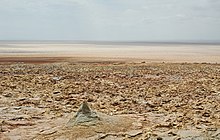Danakil Somalia


Danakil-Somalia is a name chosen by the desert researcher Théodore Monod for the three larger desert regions in northeastern Africa . Monod includes the deserts of Somalia and the Danakil desert, but leaves out the deserts of northern Kenya . In general, there is no uniform name for the interconnected deserts, semi-deserts and savannas of Northeast Africa. So there is also the term "deserts of the Rift Valley", although the Somali Peninsula does not belong to the " East African Rift System ", the East African Rift Valley .
Danakil
The Danakil Desert is located on the Red Sea coast in the Afar Triangle in Eritrea , Ethiopia and Djibouti . It is one of the world's most geologically active areas, including the Erta Ale , Asavyo and Dabbahu volcanoes . The Dallol thermal area is also worth mentioning . In the west it is bounded by the steep Abyssinian highlands .
From a geological point of view, the Danakil is a dry seabed. The region lies in the spreading zone of the East African Rift Valley and continues to sink due to tectonic processes. The floods of the Red Sea are only held back by a narrow mountain bar. The huge salt deposits and fossilized corals lying around on the desert floor testify that there has been an ocean here before.
The Danakil Depression (also: Danakil Depression , 110 m below sea level), which lies in the lee of the highlands of Abyssinia, is hyperarid , i.e. very dry. The Danakil is one of the hottest and driest deserts on earth. Ground temperatures of up to 70 degrees Celsius have already been measured here. There are practically no roads made of asphalt, because in the blazing sun it would melt, or at least become soft.
The Danakil is often referred to as the "hellhole of creation", as it is believed that this is the cradle of mankind. Hominid remains almost 2 million years old have been found here. New theories assume that Homo sapiens developed in this area and spread from here. Of course, the climate at that time was cooler and more humid.
Around 100,000 Afar nomads live in the desert . Since the fall of the Mengistu regime in Ethiopia in 1991, some resistance fighters have remained militarily active, which is why the region is still unsafe today. The capital of the Afar region is Asayita ( Aussa ). A sultanate of Aussa existed until 1888, its borders roughly correspond to today's Afar region along the Awash River .
Northern Kenya
Another desert lies between Lake Turkana and Marsabit in northern Kenya . In the vicinity of Marsabit there is a high volcanic massif with a cloud forest . The northern part is called "Chalbi Desert", the southern part "Kaisut Desert". Both are typical nomadic land : 70,000 Boran live between Marsabit and Ethiopia , 30,000 Gabbra to the west of it, Samburu and Rendille to the south, and the Turkana to the west of the lake . The nomadic people live from cattle and camel breeding , which can often lead to cattle being stolen .
Somali Peninsula
The desert on the Horn of Africa , which joins the Danakil, has hardly been explored, as the political situation has been uneasy for years. The country drops from medium altitudes to the Indian Ocean , in the north - to the Gulf of Aden - there are mountains up to 2,000 m high along the coast .
Emergence
On the one hand, the north-east trade wind causes hot and dry air masses to come from the Arabian Peninsula and humid equatorial air to be displaced. On the other hand, the East African Trench also influences the amount of rain: there is far less rainfall in the lee of the trench.